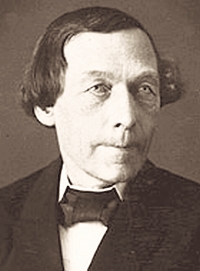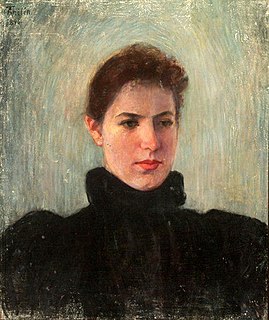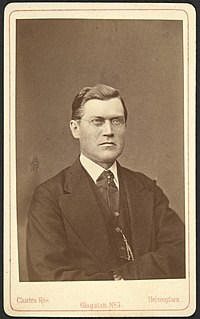Related Research Articles

Johan Vilhelm Snellman was an influential Fennoman philosopher and Finnish statesman, ennobled in 1866. He was one of the most important 'awakeners' or promoters of Finnish nationalism, alongside Elias Lönnrot and J. L. Runeberg.

Finnicization is the changing of one's personal names from other languages into Finnish. During the era of National Romanticism in Finland, many people, especially Fennomans, finnicized their previously Swedish family names.

Carl Ludvig Engel, or Johann Carl Ludwig Engel, was a German architect whose most noted work can be found in Helsinki, which he helped rebuild. His works include most of the buildings around the capital's monumental centre, the Senate Square and the buildings surrounding it. The buildings are Helsinki Cathedral, The Senate, the City of Helsinki Town Hall, and the library and the main building of Helsinki University.

Henrik Gabriel Porthan was a professor and rector at the Royal Academy of Turku. He was a scholar sometimes known as The Father of Finnish History.

William (Wilhem) Nylander was a Finnish botanist and entomologist. Nylander was born in Oulu, and taught at the University of Helsinki before moving to Paris, where he lived until his death in 1899.

Fabian Wrede was a Swedish politician.

Robert Kajanus was a Finnish conductor, composer, and teacher. In 1882, he founded the Helsinki Orchestral Society, Finland's first professional orchestra. As a conductor, he was also a notable champion and interpreter of the music of Jean Sibelius.

The National Library of Finland is the foremost research library in Finland. Administratively the library is part of the University of Helsinki. From 1919 to 1 August 2006, it was known as the Helsinki University Library.
Gabriel Tammelin was vicar of Lohja, and a collector and translator of Finnish proverbs.

The Finnish Evangelical Lutheran Mission is a Lutheran missionary society formed on January 19, 1859, in Helsinki, Finland. It is one of seven organisations of the Evangelical Lutheran Church of Finland (ELCF) that conduct missionary work. Its first deployments outside Finland were made to Ovamboland, an area that today is cut by the Angola-Namibian border.
Klemens Johan Gabriel Sirelius was the first director of the Finnish Missionary Society. He served in this position from 1872 to 1876. During his tenure the mission society was organised and the first missionaries were sent to Ovamboland in South West Africa. The last years of his life he served as the vicar of Mikkeli.

Synty is an important concept in Finnish mythology. Syntysanat ('origin-words') or syntyloitsut ('origin-charms') provide an explanatory, mythical account of the origin of a phenomenon, material, or species, and were an important part of traditional Finno-Karelian culture, particularly in healing rituals. Although much in the Finnish traditional charms is paralleled elsewhere, 'the role of aetiological and cosmogonic myths' in Finnic tradition 'appears exceptional in Eurasia'. The major study remains that by Kaarle Krohn, published in 1917.
Æschillus (Eskil) Petræus was Bishop of Turku in 1652–1657.
Elisabet Wittfooth née Tottie was a Finnish merchant and shipowner.
Elin Såger (1614–1669) was a Finnish businessperson.

Ada Maria Thilen was a Finnish painter known for her landscapes.
Itärata is a proposed railway line in the planning stage to provide a more direct connection between Helsinki and Kouvola, Finland than the current route via Kerava and Lahti.

Pietari (Petter) Mikonpoika Hannikainen, surname changed to Hanén during his early years of studying until 1852, was a Finnish writer, journalist and surveyor, and a member of the Hannikainen family of writers and musicians.

Anders Thiodolf Saelan (Sælan) was a Finnish physician and botanist. He reformed Finnish mental health care during his decades as chief physician of Lapinlahti Psychiatric Hospital in Helsinki.
Karl Fredrik Bergh, sometimes known as Carl Fredrik Berg, in Finnish as Kaarle, and in Latin as Carolus Fridericus Berg, was a cleric and scholar, noted for his interest in oral Finnish literature.
References
- ↑ Yrjö Kotivuori, Ylioppilasmatrikkeli 1640–1852: Gabriel Maxenius. Verkkojulkaisu 2005 <http://www.helsinki.fi/ylioppilasmatrikkeli/henkilo.php?id=5700>. Accessed 10 June 2016.
- ↑ Yrjö Kotivuori, Ylioppilasmatrikkeli 1640–1852: Gabriel Maxenius. Verkkojulkaisu 2005 <http://www.helsinki.fi/ylioppilasmatrikkeli/henkilo.php?id=5700>. Accessed 10 June 2016.
- ↑ Yrjö Kotivuori, Ylioppilasmatrikkeli 1640–1852: Gabriel Maxenius. Verkkojulkaisu 2005 <http://www.helsinki.fi/ylioppilasmatrikkeli/henkilo.php?id=5700>. Accessed 10 June 2016.
- ↑ Gabriel Maxenius, De effectibus fascino-naturalibus, eli, Runoloitsujen vaikutuksista, ed. and trans. by Nils-G. Hublin (Kuopio: [Kuopion yliopisto], 1985); facsimiles of the original publication at http://urn.fi/URN:NBN:fi-fd2013-00003262 and http://urn.fi/URN:NBN:fi-fd2014-00005180.
- ↑ Clive Tolley, Shamanism in Norse Myth and Magic, FF Communications, 296-297, 2 vols (Helsinki: Academia Scientiarum Fennica, 2009), I 81.
- ↑ Yrjö Kotivuori, Ylioppilasmatrikkeli 1640–1852: Gabriel Maxenius. Verkkojulkaisu 2005 <http://www.helsinki.fi/ylioppilasmatrikkeli/henkilo.php?id=5700>. Accessed 10 June 2016.
- ↑ Yrjö Kotivuori, Ylioppilasmatrikkeli 1640–1852: Gabriel Maxenius. Verkkojulkaisu 2005 <http://www.helsinki.fi/ylioppilasmatrikkeli/henkilo.php?id=5700>. Accessed 10 June 2016.